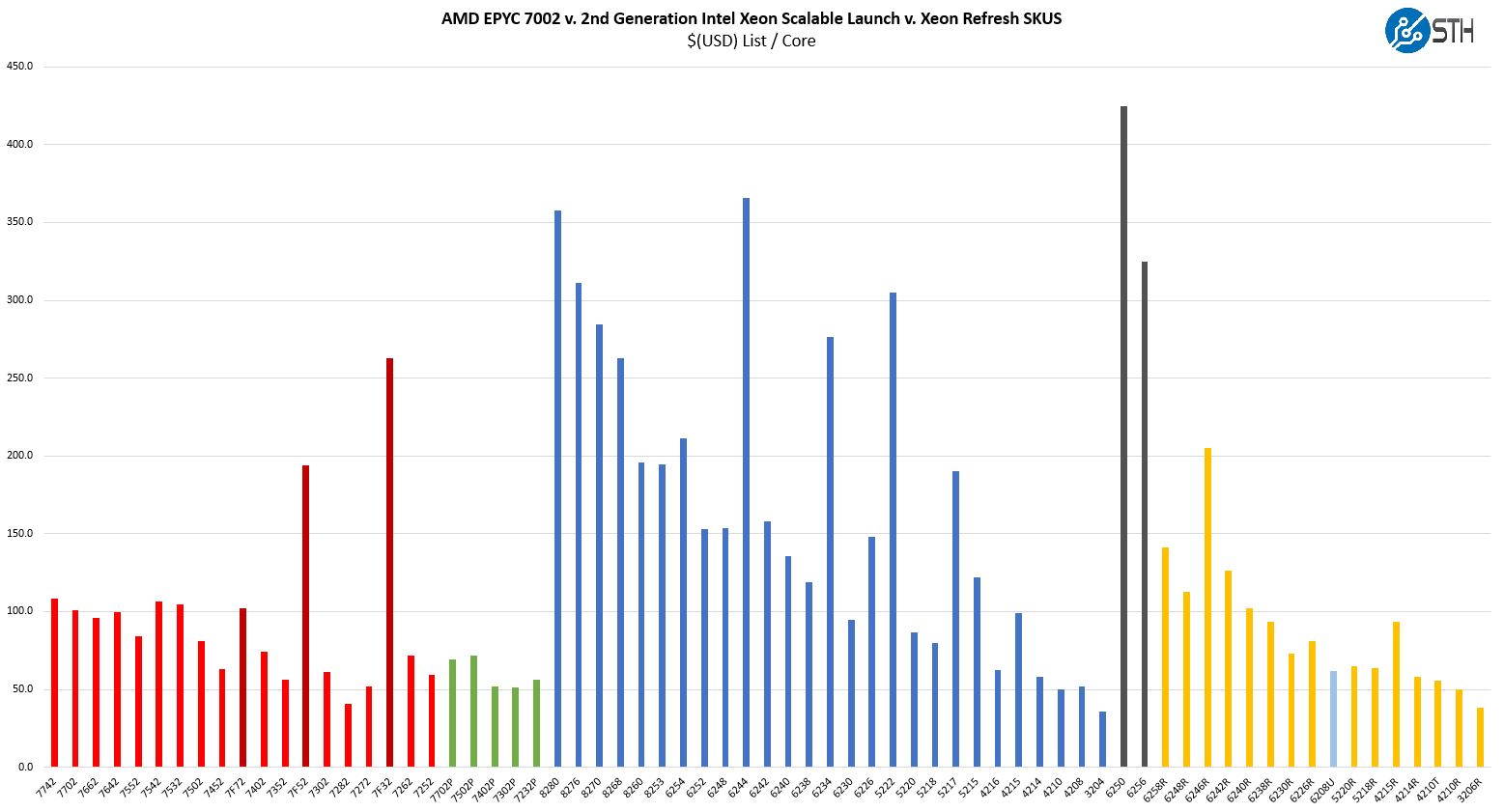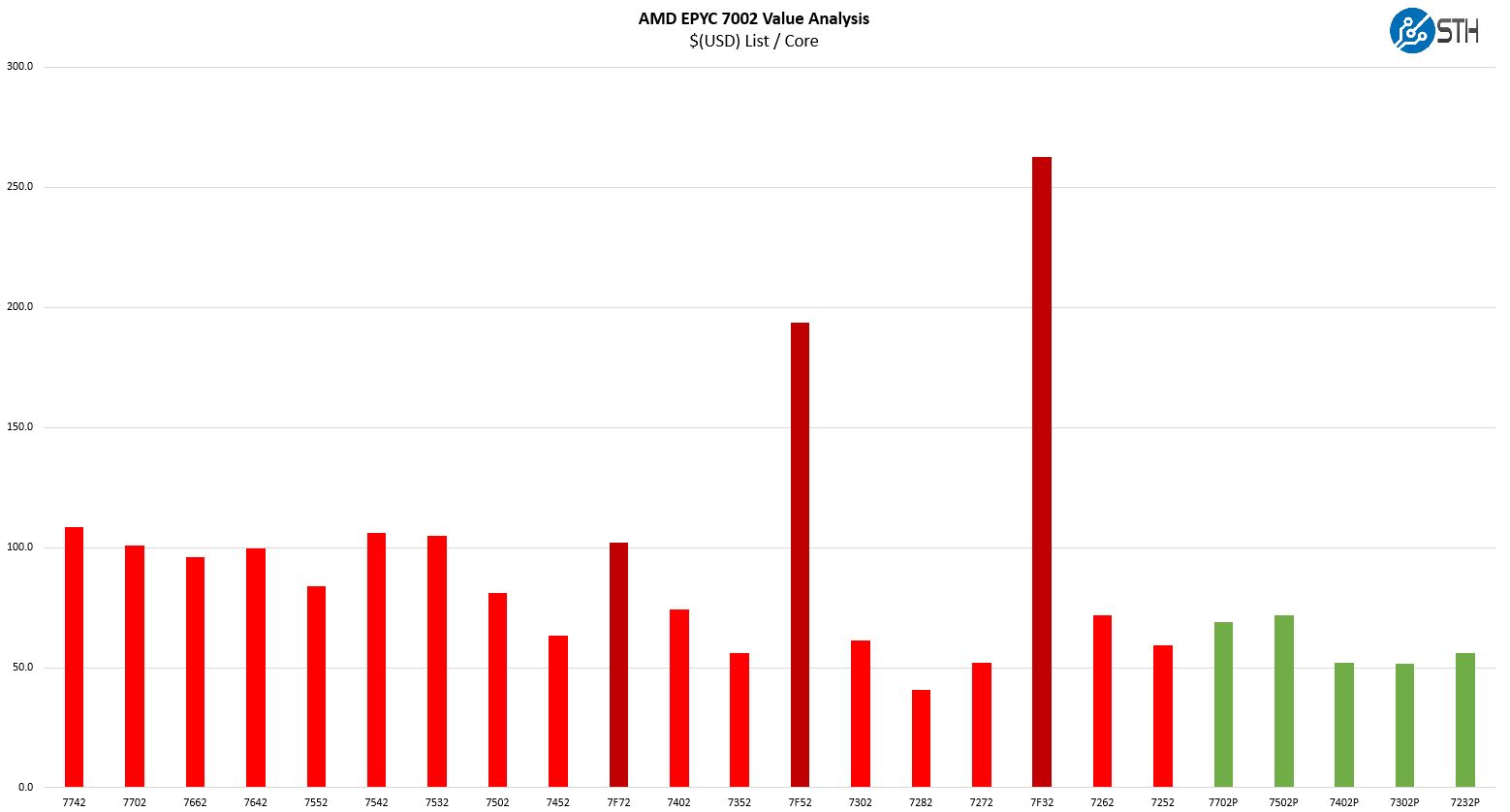AMD EPYC 7F72 Market Positioning
Thes chips are not released in a vacuum instead, they have competition on both the Intel and AMD sides. When you purchase a server and select a CPU, it is important to see the value of a platform versus its competitors. Here is a look at the overall competitive landscape in the industry:

We are going to first discuss AMD v. AMD competition then look to Intel Xeon.
AMD EPYC 7F72 v. AMD EPYC
One of the nice features surrounding a frequency optimized part is that there are only a few effective competitors. There are the other 24-core SKUs in AMD’s stack as well.

Here we can see that the AMD EPYC 7F72 is around 37% more expensive per core than the EPYC 7402. That puts it more in-line with the higher-end 32 core parts on a price per-core basis, but not into the steep premiums we see on the other “F” SKUs. If you have some moderately priced licensed by core software, then this is going to be a small premium to pay.

One gets significantly more performance, but there is a large TDP delta to accompany that change. The 240W number is 85W, or about the TDP of an Intel Xeon Silver 4208 difference.
We did want to discuss operating costs as well. There is another impact of the 240W TDP. Many 2U 4-node systems today are not designed to cool two 240W TDP CPUs per node or 1.92kW of CPU TDP in a 2U box. We have seen many designs such as the Gigabyte H262-Z62 2U 4-node server that can handle 225W TDP CPUs but cannot, for example, populate all front-panel SSDs with that high of TDP CPUs installed. Moving to a 240W TDP platform further exacerbates the concern. This is just on the cusp where we will see some vendors build exotic air cooling solutions and others start to yield to liquid-cooled designs.
AMD EPYC 7F72 v. Intel
Although the AMD EPYC 7F72 a few months ago would have launched versus the Intel Xeon Platinum 8268, a $6,302 part, we are now in a different world. The first development has been the Big 2nd Gen Intel Xeon Scalable Refresh which up-ended the competitive landscape. Intel effectively dropped prices across most of its mainstream CPUs.
In the segment most competitive with the EPYC 7F72, we now have the Intel Xeon Gold 6248R. The Xeon Gold 6248R is a $2700 list price part with lower TDP, lower base clock speeds, higher turbo speeds, but significantly less L3 cache 35.75MB v. 192MB. While the Xeon Gold 6248R gets AVX-512, DL Boost, and Optane DCPMM support AMD has other features. Namely, EPYC 7F72 has 4TB DDR4-3200 8-channel support (v. 1TB DDR4-2933 6-channel support.) The EPYC “Rome” generation also has more PCIe lanes and uses PCIe Gen4 versus Gen3 with the Xeon Gold.
That Xeon Platinum 8268 is not necessarily a competitor now, but the Intel Xeon Platinum 8260L is Intel’s high memory (up to 4.5TB) 24-core part. This is a lower TDP part (165W) but it is one of Intel’s better offerings for 24-cores, 3x UPI links, and high-memory configurations. That extra UPI link can be important in systems such as the Inspur NF5488M5 8x NVIDIA Tesla V100 Server we recently reviewed. The EPYC 7F72 has a platform feature set that is much closer to the Xeon Platinum L SKUs in many ways than the newer R SKUs for big I/O and memory platforms.
AMD now has an extremely competitive offering. The parts do not have enormous price deltas versus refresh SKUs like the Gold 6248R, but AMD is still providing a discount for more performance and a bigger platform.
Final Words
There are a few caveats here. Many readers who do not have to deal with per-core licensing and just want 24 lower power cores for single-socket servers are going to find the AMD EPYC 7402P much more attractive. The 240W TDP cooling requirement most 1U per node and 2U per node systems can handle without an issue for dual-socket configurations but there are going to be 2U 4-node systems that cannot be fully populated with the EPYC 7F72. We are going to urge our readers to double-check these systems before making assumptions.
Still, AMD has an extremely competitive part with the Intel Xeon Gold 6248R, and at a lower price as well. For many applications that can utilize the massive cache structure that AMD has in place and all of the platform I/O, AMD has something uniquely special in the segment with the EPYC 7F72.




I know STH dont normally write anything on stocks and quarterly reports. But I do wish STH write a pieces that suggest why EPYC is doing as good as most of us expected it to be. It has yet to break the 10% shipment barrier, all while Intel is making record quarter YoY in DC and HPC. That is all in the time when Intel 14nm is operating at full capacity and one node behind.
Most have been suggesting these things takes time, but it is already a year of Zen 2 and shows no signs of improvement.
Can we have the single threaded results for the UnixBench Dhrystone 2 and Whetstone Benchmarks on a separate axis or chat?
For a part that is specifically targeting better single threaded performance, it would be nice to have a little more focus on that aspect. A lot of problem domains enjoy multi-threaded environments, there are still others which focus on raw single threaded performance. A comparison here to Intel’s similar offerings would be very beneficial.
A great article as usual and I very much enjoy reading STH content, hopefully the feedback will be helpful. Thanks
@Stephen,
Given that this and the rest of the CPUs are intended for use in server system, why would single threaded performance matter?
Servers are purchased/justified on the basis that they provide resources for a number of tasks, so they are never running “one thing”. Further, single threaded processes would not be representative of real usage, since each CPU has there own inherent trade offs — higher base clocks vs. more cores/threads vs. TDP.
wow this is beast wondering how it will feel like setting this 24 core cpu as gaming pc by adding rtx 280 gpu along it.
Again an irrelevant review of a core frequency optimized part.
All your benchmarks shows that more cores are better than fewer but frequency optimized cores.
I sound like a broken record player repeating the same request over and over….
Please add variations of the benchmarks where there are 4 – 8 threads active!
That will show what these parts are made for and will also show the value of turbo modes, high TDP.
It may also show the only remaining performance reason to pick Intel in 2020.
@BinkyTo,
Latency sensitive applications care about single-threaded performance. We run multiple processes per server, there is of course a trade off between singled-threaded performance and number of cores available that we have to make. However doubling the number of cores while taking 20% off the clock speed is going to make us go slower, not faster.
Details about turbo modes, all-core and subset core would also be very interesting and information is often difficult to find.
@zack – it would feel expensive.
As a frequency part, should not there be more database related benchmarks?
This processor is for use with Oracle or SQL Server, too. THAT is what datacenter servers do. In those scenarios, doubling cores while dropping GHz could-very-well be a WIN.